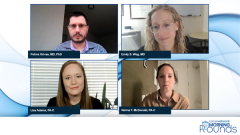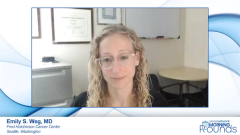
Advanced Bladder Cancer: Informing Selection of 2L Therapy
Leaders in bladder cancer management consider factors that aid in their selection of second-line therapy.
Episodes in this series

Transcript:
Petros Grivas, MD, PhD: Now we have a few minutes left and I want to move on. How [do] we approach these and other patients who may have progression on treatment? We know that this metastatic disease is palliative treatment intense and the prognosis of those patients can vary, but we see that improves over time with more options being available. Now, let's say the patient 1 year after starting avelumab maintenance has a progressive disease. And the question is, how do we discuss this with that patient? How do we communicate? Do we bring them into the clinic? How do we discuss options? Is there anything you can comment on, Nerina? At the time of progression, we have antibody-drug conjugates, we have erdafitinib, what factors do we take into account, medical comorbidities, and organ function to help them make this decision? Maybe IV [intravenous] vs PO [oral administration]? Or anything that comes to mind?
Nerina T. McDonald, PA-C: Definitely what their comorbidities are, I mentioned earlier, enfortumab has the risk of hyperglycemia. So, if there's a patient that's having uncontrolled diabetes, that might not be the best next option. Or prior neuropathy from chemotherapy, erdafitinib requires some more intense laboratory monitoring and ophthalmologic exam. So that's another consideration that is made there. But usually, we'll bring the patient back into clinic to review the scans that did show progression, and then have a discussion with the oncologist where they outline what expected response rates would be with each therapy, what adverse effects we typically are experiencing, what the monitoring process and how often they would be coming in for visits and that type of thing.
Petros Grivas, MD, PhD: Absolutely. I think all those factors are very relevant. Lisa, [do you have] anything to add to that discussion? It's a decision point, right? The patient has progression, chemotherapy, immunotherapy maintenance, and avelumab progression. What do you discuss with the patient in clinic to help them decide on the next treatment option?
Lisa Adams, PA-C: I think it’s important for patients to know the data from the clinical trials and the endpoints that really resonate with them. Often patients will ask, what are the chances this will help me? And I feel like that's really reflected in overall response rates. And then, how long can I expect this to reasonably work? So, that would be progression-free survival. I think those are the things that we discuss with patients in general terms and in patient-friendly language. And then lay out the options and here is what each of those options will look like as far as Nerina mentioned, lab monitoring, visits in the clinic, and then thinking about those patient -specific factors. Are there any late effects from their chemotherapy or immunotherapy that might pose special challenges or other comorbid conditions that might pose special challenges? So, usually, that helps direct where we go next. And then, of course, getting the molecular testing and seeing if there are any targetable options. Sometimes that's very attractive for patients as well.
Petros Grivas, MD, PhD: Absolutely. And talking about molecular testing, we discussed before, Lisa, that we have the option of erdafitinib in some of the patients. And as Nerina mentioned, this requires next-generation sequencing to be done ideally at the diagnosis of metastatic disease. And if someone has an FGFR2 or FGFR3 mutation or fusion, now we have actual data for erdafitinib. We just saw data from ASCO [the 2023 American Society of Clinical Oncology Annual Meeting] last week. There was an overall survival benefit with erdafitinib compared [with] taxane, docetaxel, or paclitaxel in Europe, suggesting that erdafitinib has level 1 evidence.
It comes down to the sequence of therapies. And to your point, as you both mentioned, medical comorbidities, organ function, patient preference, oral vs IV, distance from the cancer center, toxicity profile of those drugs, enfortumab, trastuzumab, erdafitinib can help us decide the optimal sequence. Because we don't have a lot of trials guiding us, what should be used first, and what should be used second. Enfortumab and erdafitinib have level 1 evidence with phase 3 trials. Trastuzumab has phase 2 data with a phase 3 trial pending. So, I think it's becoming more optimistic for the patients who have options. Back in the day, 7 years ago, we did not have any of those options. So, it's encouraging to see them in practice. We talked before about the need, to take into account the somatic testing.Nerina, you mentioned germline testing. Could you comment a little bit more about how we discuss with the patients the distinction between tumor somatic testing for treatment target approach vs genetic counseling, which is more of a prevention approach for them and their families?
Nerina T. McDonald, PA-C: Typically, we'll have a discussion about germline testing and actually refer the patients to genetic counseling to review their family history. And then the genetic counselor, once the testing comes back, can provide recommendations for family members that may be impacted if the patient does have some type of hereditary mutation. So, screening implications for their biological children, etc. And then, when I'm counseling patients about genomic somatic testing, I let them know this is very specific to your actual tumor and this is going to provide us information for what your tumor mutations might be at this exact stage. And then we may have this conversation again 5 years down the line after you've received some interval therapies that could potentially change how the tumor is looking later on.
Petros Grivas, MD, PhD: Absolutely. [Those are] great points. We try to educate the patient and make these distinctions. [Do you have] any comments, Lisa, about your practice and tumor genomic profiling for therapy purposes and genetic counseling/germline testing?
Lisa Adams, PA-C: We're very lucky that our genetic counselors do participate on our tumor boards and they help us identify which patients are appropriate to meet with them for genetic testing. And then as far as the tumor testing, of course, tissue is always preferred for next-generation sequencing, but sometimes when people are relapsing, if there aren't any sites amenable to new biopsy, we also discuss circulating tumor DNA testing, which is a very convenient option for patients as well. And of course, if that's negative, then we would prefer tissue to confirm. But if it did show actionable alterations, then it's a nice option to have for patients.
Petros Grivas, MD, PhD: Absolutely. I agree with you that tumor tissue is standard, but we tend to use more and more circulating tumor DNA. As we go through the look at the clone evolution of the disease and how it might progress over time and to identify potential targets for clinical trials, some of the clinical trials require particular genomic alteration. So, I tell the patient, we use genomic sequencing to look for erdafitinib FGFR inhibitor, but also potential targets for other trials.
Transcript edited for clarity.
Newsletter
Stay up to date on recent advances in the multidisciplinary approach to cancer.



































































































